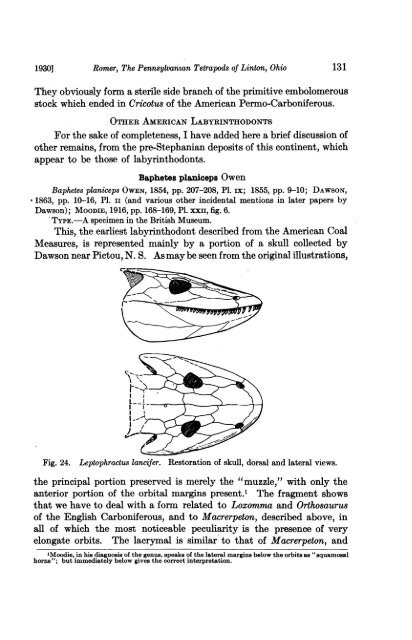View/Open - American Museum of Natural History
View/Open - American Museum of Natural History
View/Open - American Museum of Natural History
You also want an ePaper? Increase the reach of your titles
YUMPU automatically turns print PDFs into web optimized ePapers that Google loves.
19301<br />
Romer, The Pennsylvanman Tetrapods <strong>of</strong> Linton, Ohio<br />
131<br />
They obviously form a sterile side branch <strong>of</strong> the primitive embolomerous<br />
stock which ended in Cricotus <strong>of</strong> the <strong>American</strong> Permo-Carboniferous.<br />
OTHER AMERICAN LABYRINTHODONTS<br />
For the sake <strong>of</strong> completeness, I have added here a brief discussion <strong>of</strong><br />
other remains, from the pre-Stephanian deposits <strong>of</strong> this continent, which<br />
appear to be those <strong>of</strong> labyrinthodonts.<br />
Baphetes planiceps Owen<br />
Baphetes planiceps OWEN, 1854, pp. 207-208, P1. ix; 1855, pp. 9-10; DAWSON,<br />
1863, pp. 10-16, P1. II (and various other incidental mentions in later papers by<br />
Dawson); MOODIE, 1916, pp. 168-169, P1. xxii, fig. 6.<br />
*TYPE.-A specimen in the British <strong>Museum</strong>.<br />
This, the earliest labyrinthodont described from the <strong>American</strong> Coal<br />
Measures, is represented mainly by a portion <strong>of</strong> a skull collected by<br />
Dawson near Pictou, N. S. Asmaybe seen from the original illustrations,<br />
Fig. 24. Leptophractus lancifer. Restoration <strong>of</strong> skull, dorsal and lateral views.<br />
the principal portion preserved is merely the "muzzle," with only the<br />
anterior portion <strong>of</strong> the orbital margins present.' The fragment shows<br />
that we have to deal with a form related to Loxomma and Orthosaurus<br />
<strong>of</strong> the English Carboniferous, and to Macrerpeton, described above, in<br />
all <strong>of</strong> which the most noticeable peculiarity is the presence <strong>of</strong> very<br />
elongate orbits. The lacrymal is similar to that <strong>of</strong> Macrerpeton, and<br />
'Moodie, in his diagnosis <strong>of</strong> the genus, speaks <strong>of</strong> the lateral margins below the orbits as " squamosal<br />
horns"; but immediately below gives the correct interpretation.
















